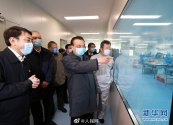You are using an out of date browser. It may not display this or other websites correctly.
You should upgrade or use an alternative browser.
You should upgrade or use an alternative browser.
Coronavirus 2019-2020 thread (no unsubstantiated rumours!)
- Thread starter localizer
- Start date
Another possibility is that she and her party are trying to make money out from the pandemic. I heard from one report that the Japanese parliament was interrogating its foreign minister why only donate 1.54m doses to Taiwan. He answered that the Taiwan side only request that many doses because they will have enough production by July. If these are true, Tsai's administration clearly want to wait for their local vaccine.
Hmmmm.

That’s is pretty risky. For one, it might not even work. I know Australia tried and failed when potential vaccine it was researching on caused a false positive hiv result!Another possibility is that she and her party are trying to make money out from the pandemic. I heard from one report that the Japanese parliament was interrogating its foreign minister why only donate 1.54m doses to Taiwan. He answered that the Taiwan side only request that many doses because they will have enough production by July. If these are true, Tsai's administration clearly want to wait for their local vaccine.
for another, even if it works it might come with serious side effects like the AZ one
I was working in the first wave here in the UK. The quality of masks we had were abysmal throughout it. At the same time the PM was talking about sourcing PPE being a number one priority, the media tracking cargo planes coming from Turkey, there still was a massive shortage of everything.
In theory we can buy anything we want but normally would go with with the "national" procurement system. Normally they are quite good quality but during the pandemic everything became a mystery box.
With our first delivery. The first boxes of masks we had were out of date, someone put a sticker with a new date over it. I half peeled it off and took a picture of it - I'll save it to show my grandkids one day how much of a mess the system was. I'm sure it was found in some abandoned warehouse somewhere and pressed into service.
After that the masks quality of the masks actually became worse. They'd often tear when you're putting them on. Around October last year the quality improved, but there were still so many of the old ones that fell apart. I believe someone bought so many of them and now it was too late. No one wanted to toss them away. It took months for them to be used up.
I can only speak for what was going on in China. But it sounds like there were serious issues with the procurement process in the UK.
For one, none of the masks made here had a "best before" date. The government mandates that certain information must be included on the packaging, including date of production, place of origin, validity period (usually 2 years or 18 months from production date), model name and number, etc. Wherever your masks were sourced from, they clearly had some serious QC issues.
I contacted the NHS and procurement channels in the UK multiple times in June 2020. Same response every time: "We have enough supply of masks, don't need more thanks." Clearly there was a severe shortage on the ground, yet these institutions weren't willing to buy more. Or maybe it was due to political reasons that they didn't want to buy from a Chinese exporter, and preferred to continue struggling with a shortage instead?
I agree that the first few batches of masks were abysmal. In my factory we struggled to get the manufacturing right for the first few weeks but after experience with supplying the domestic market, the quality gradually became better for export. By April 2020 there weren't any more major defects (e.g. ear loops coming off, metal strip falling out).
broadsword
Brigadier
From the photos I've seen in China they generally are made in clean rooms:@Higgle
Shouldn't masks be made in a clean room environment devoid of human contact? The only company with a clean room I have seen is one in Singapore.

This was Feb 2020
@Higgle
Shouldn't masks be made in a clean room environment devoid of human contact? The only company with a clean room I have seen is one in Singapore.
There are different grades of masks and different grades of clean rooms. If we were making computer chips, we would need a clean room "devoid of human contact" but it's not necessary to go that far for masks.
Surgical masks (and other medical-grade devices) are made in a basic low-level clean room which filters out most large particles. The ear-loops then have to be attached manually by workers using ultrasonic welding machines. Anyone entering the production area has to wear disposable overalls.
This only applies to medical/surgical masks as they need to be tested for microbial cleanliness (i.e. cleanliness from germs and microbes). Non-medical KN95s were not fully designed for use in a medical environment and therefore don't have this test requirement, so they don't need to be made in a clean room.
In practise, medical and non-medical KN95s are very similar. The filtration requirements are the same. The main difference is that medical-grade respirators have fluid protection to protect wearers against bodily fluids and spray during invasive surgery. So for the vast majority of medical staff in a pandemic situation, non-medical KN95s are actually quite sufficient.
broadsword
Brigadier
There are different grades of masks and different grades of clean rooms. If we were making computer chips, we would need a clean room "devoid of human contact" but it's not necessary to go that far for masks.
Surgical masks (and other medical-grade devices) are made in a basic low-level clean room which filters out most large particles. The ear-loops then have to be attached manually by workers using ultrasonic welding machines. Anyone entering the production area has to wear disposable overalls.
This only applies to medical/surgical masks as they need to be tested for microbial cleanliness (i.e. cleanliness from germs and microbes). Non-medical KN95s were not fully designed for use in a medical environment and therefore don't have this test requirement, so they don't need to be made in a clean room.
In practise, medical and non-medical KN95s are very similar. The filtration requirements are the same. The main difference is that medical-grade respirators have fluid protection to protect wearers against bodily fluids and spray during invasive surgery. So for the vast majority of medical staff in a pandemic situation, non-medical KN95s are actually quite sufficient.
Is the fabric imported? I read that it was sourced from Switzerland. If it is, why is there no local company making it?
Is the fabric imported? I read that it was sourced from Switzerland. If it is, why is there no local company making it?
The majority of meltblown polypropylene (i.e. the filtration fabric) is not imported. Given the choice, every mask manufacturer would prefer to buy it domestically as they have the best prices. I have heard a few cases of imported meltblown from countries like Brazil or Korea in other factories, but the majority is still sourced locally.
As I mentioned before, mask production became quite ridiculous and the fabric supply could not keep up. Only a few companies had experience making high-grade meltblown PP (usually conglomerates like Sinopec, or China Petroleum) and their production was completely full. To make it worse, there were also many hoarders and scalpers. Pre-pandemic it cost 20k yuan for 1 ton of meltblown, but during mid-2020 it peaked at 700k for 1 ton. That's the biggest reason why KN95 prices (at wholesale) ballooned from 50 cents in February 2020 to almost 2 dollars in May 2020.
After several weeks of fruitless searching for legit high-grade meltblown, our factory set up our own production in-house to supplement the scarce supply from outside suppliers. It was difficult and the quality was terrible at first, but eventually we got it to an acceptable level (~70% PFE) and began to use it in masks. By double or triple-layering the fabric, we can achieve 95% in the final product which passes as a KN95.
This medium-grade meltblown is also good to use in surgical masks as the filtration requirements are lower, only 90-95% BFE needed vs 95% PFE for KN95s. BFE stands for Bacteria Filtration Efficiency which means the filtering of particles of 3.0 microns. PFE, Particle Filtration Efficiency, measures the filtering of ALL particles, tested using 0.3 micron particles which are the most difficult to capture.
Last edited:
CGTN street interviews Taiwanese regarding their vaccine dilemma. Although I expected that CGTN will be very biased in their reporting, this video is rather neutral, with little political innuendos that we are used to seeing elsewhere. Actually, I am wondering how did CGTN reporters get their press credentials from Taipei considering the bellicosity of the DPP.
